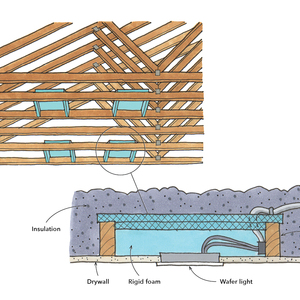Q:
We recently purchased a 100-year-old Victorian house in Illinois. The wood siding was badly neglected, and we’re considering putting up vinyl siding. Should we retrofit some type of vapor barrier before installing the vinyl?
Theodore R. Knack, Johnson City, NY
A:
George Nash, author of Renovating Old Houses , replies: I don’t recommend vinyl for re-siding old houses. Placing vinyl over the old wood siding can mask or even cause water damage. Also, vinyl siding can act like an exterior vapor barrier, trapping moisture within the walls and abetting decay. In very cold weather, vinyl cracks easily, and its color will fade over time. Instead, remove the old siding and consider using fiber-cement siding (FibreCem Corp., P. O. Box 411368, Charlotte, N. C. 28241; 704-588-6693) as an alternative to wood. This new product, warranted for 50 years, is a composite of portland cement and cellulose. Fiber-cement siding is installed like any lap siding, but I’d use stainless-steel nails. It’s best to nail directly into studs unless you’ve got beefy sheathing.
Fiber-cement siding comes in 12-ft. lengths, and you butt the lengths with joiner clips that automatically align the two pieces. For big jobs you should invest in a diamond-tip masonry blade to cut the siding, but you could get away with a masonry cutoff blade on a smaller job. Although you don’t have to paint fiber-cement siding (its color is very close to that of concrete), I would imagine a Victorian house would look better painted. The nice thing about fiber-cement siding is that once it’s painted, the paint job lasts about 10 years. Fiber-cement siding is noncombustible; it doesn’t rot, dent or crack, and termites won’t eat it. The siding comes in different textures, including wood grain, and it costs about the same as vinyl siding.
Whatever siding you do use, it’s absolutely critical that you leave the original trim intact. Although stripping and repainting is undeniably labor intensive, to yield to the temptation to cover the trim with vinyl siding would do irreparable harm to the aesthetic and architectural character of the house.
When you put up the new siding, make sure the seams between it and the old trim are tight. Cut rabbets in wood drip caps and sills to channel water away from the siding and use copper or galvanized-steel flashing (both of which are superior to aluminum) to prevent possible water traps. I often use prepainted galvanized coil stock (Ideal Roofing Co., Ltd., 1418 Michael St., Ottawa, Ont., Canada K1B3R2; 613-746-3206). Don’t rely solely on caulking; even the highestquality acrylic copolymer caulking, such as Geocel (Geocel Corp., P. O. Box 398, Elkhart, Ind. 46515; 219-264-0645) will eventually fail if it’s the only defense against water penetration.
As far as tightening up the house itself, apply an anti-infiltration membrane, such as Tyvek, over the sheathing before installing the new siding. This membrane prevents outside air from getting into the house, making it easier to maintain internal humidity while reducing the chances of condensation. Wherever possible, slide the membrane up under the trimboards. With the old siding removed, you can also blow additional fiberglass or cellulose insulation into the wall cavities before re-siding.
Although it’s not mentioned in your question, I’m assuming the interior walls are plastered. Old three-coat plasterwork is actually a fairly good vapor barrier, especially when painted with a vapor-retardant paint. Caulk all the joints between trim and wall surfaces before applying the paint.
Adding storm windows or double-glazed replacement windows is a necessary part of any moisture-control program, and so is the installation of a vapor barrier over a bare-earth cellar floor. This vapor barrier should be a heavy polyethylene that’s covered with an inch of sand and 3 in. or 4 in. of crushed stone. Alternatively, you could pour a concrete slab over the poly. All of these steps will go a long way toward curing any moisture problems.
Fine Homebuilding Recommended Products
Fine Homebuilding receives a commission for items purchased through links on this site, including Amazon Associates and other affiliate advertising programs.

Respirator Mask

Great Stuff Foam Cleaner

Insulation Knife

























